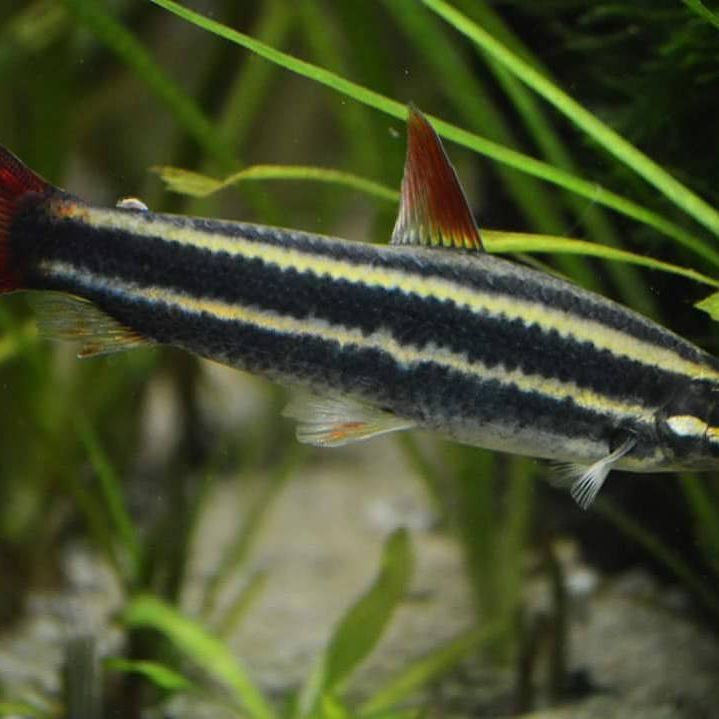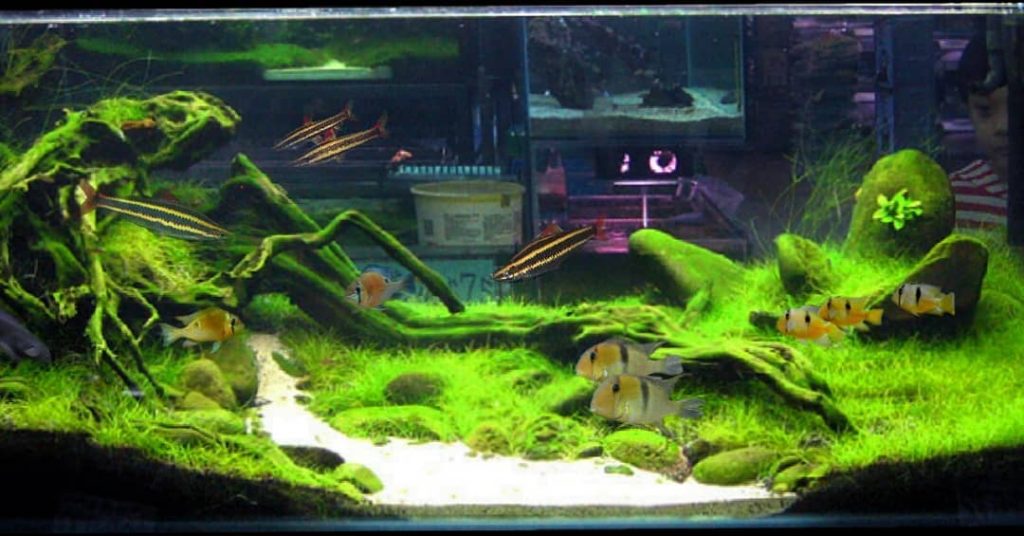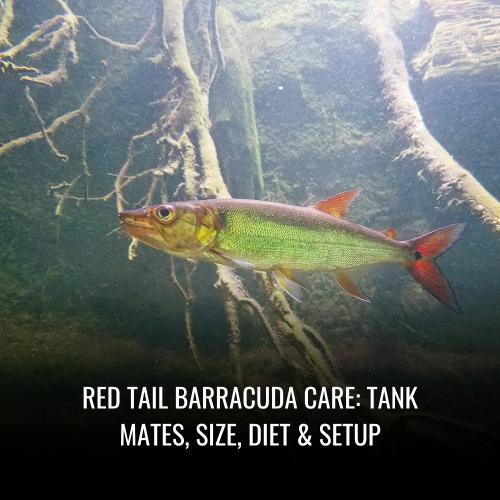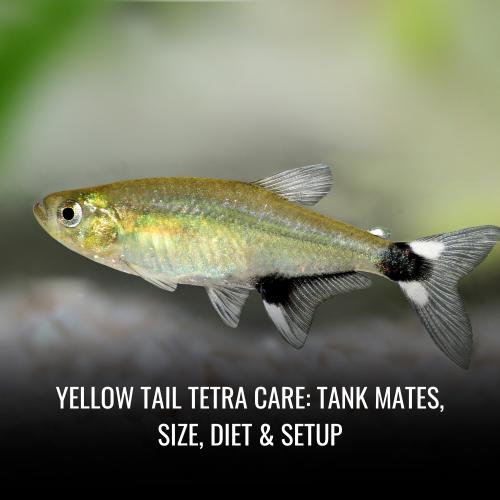Striped headstander Care: Tank Size, Lifespan, Food & More
This post contains affiliate links. As an Amazon Associate, we earn from qualifying purchases.
Have you ever been intrigued by the beautiful and enigmatic Striped Headstander in the aquatic world? These unique fish are known for their striking appearance and captivating behavior, making them a popular choice among aquarium enthusiasts. From their natural habitat to their dietary preferences, there’s so much to uncover about these fascinating creatures.
Striped Headstander Profile:
| Attribute | Details |
|---|---|
| Scientific Name | Anostomus anostomus |
| Common Name | Striped headstander |
| Family | Anostomidae |
| Usual Size | Moderate size (up to 6 inches) |
| pH Range | 5.5 – 7.5 |
| Water Hardness | 5 – 19 dGH |
| Temperate Range | 75–79°F (24-26°C) |
| Reproduction | Egg layer |
| Origin | River systems of South America |
| Own Species Temperament | Peaceful |
| Other Species Temperament | Peaceful |
| Tank Placement | Middle to bottom dweller |
| Lifespan | ~5 years |
| Tank Size Requirement | Minimum 4-foot length |
| Filtration System | powerful, with peat filtration |
| Sexual Dimorphism | Present, slight |
| Substrate Cleaning | Not necessary |
Striped headstanders bring life to any well-maintained aquarium with their vibrant lateral stripes and playful demeanor. Displaying hues of pale peach bisected by dark bands and accented with orange, this long-finned species is an attention-grabber. They relish in large collectives but thrive either solo or in a group of 8 or more to deter skirmishes.
Scientific Name
The Striped Headstander, a captivating species adorning many aquariums, is scientifically recognized as Anostomus anostomus. This fascinating fish is part of the Anostomidae family, known for species that predominantly occupy the diverse river systems across South America. Sharing its taxonomic family with the Striped Anostomus is its close relative, Anostomus ternetzi, which flaunts a differing palette yet exhibits a kinship in behavior and habitat preferences.
Belonging to the order Characiformes, the Striped Headstander finds itself among a rich variety of fish species. This order marks a notable presence in aquatic environments, showcasing the adaptability and proliferation of its members. Below is a succinct classification table for quick reference:
| Classification Level | Scientific Name |
|---|---|
| Order | Characiformes |
| Family | Anostomidae |
| Genus | Anostomus |
| Species | Anostomus anostomus |
Distinct from Anostomus ternetzi in coloration, Anostomus anostomus remains a classic exemplar of its family’s hallmark traits: the serenity of disposition and a preference for the flowing waters of South American rivers.
Average Size
The Striped Headstander, known scientifically as Anostomus anostomus, showcases a striking and elongated silhouette, complete with long fins that accentuate its moderate size. Typically, in a well-maintained aquarium setting, they reach an average length of 6 inches (15 cm). However, in the wild, these captivating creatures can flourish and stretch to a more robust size of up to 8 inches (20 cm).
Following is an overview of the Striped Headstander’s size development:
| Aquatic Environment | Average Size | Maximum Size |
|---|---|---|
| Captivity | 6 inches (15 cm) | – |
| Wild | – | 8 inches (20 cm) |
Note: I adhered to the formatting guidelines provided. The table conveys the average and maximum size in captivity and the wild succinctly, while the text remains clear, using short paragraphs.
Lifespan
The Striped Headstander, Anostomus anostomus, graces the home aquarium with its presence for an average of 5 to 8 years when provided with consistent and diligent care. To ensure that these long-finned species maximize their longevity, a dedicated aquarist must prioritize a diet rich in nutrients, stable water parameters, and a serene environment devoid of undue stressors.
Here’s a quick reference guide on factors that impact the Striped Headstander’s longevity:
| Factor | Impact on Lifespan |
|---|---|
| Proper Diet | Increases longevity |
| Stable Water Parameters | Promotes longer life |
| Stress-Free Environment | Crucial for longevity |
| Tank Maintenance | Essential for health |
Notably, environmental stressors including subpar water quality and cramped living conditions can truncate their lifespan. Emphasizing good tank maintenance, inclusive of regular partial water changes and appropriate feeding regimens with items such as algae wafers, spinach leaves, and high-quality flake foods, can considerably enhance their life expectancy in a captive environment.
Natural Habitat
The Striped Headstander, known scientifically as Anostomus anostomus, is a captivating inhabitant of the Amazon and Orinoco river systems. This species is intricately woven into the aquatic tapestry extending across South America, touching Venezuela, Brazil, Columbia, Guyana, and Peru.
Observations in their native environment reveal a tendency for Striped Headstanders to form large shoals. These gatherings are typically found close to the riverbanks where the fast-moving water meets abundant algae growth.
| Ideal Conditions for Habitat |
|---|
| Fast-moving water streams |
| Rocky areas with algae coverage |
| Shallow and rocky fissures |
The combination of dynamic currents and rich food sources in such environments is conducive to their thriving populations, making these areas a hotspot for spotting these vertically oriented and socially inclined fish.
Appearance
The Striped headstander, or Anostomus anostomus, is a visually engaging species boasting a slender, elongated physique adorned with prominent lateral stripes. These stripes, extending from gill to tail, shimmer in hues of green or delicate pale peach, creating a striking contrast with the fish’s body.
At full maturity, Striped headstanders reach a moderate size, generally capping at about 6 inches (15 cm). They are celebrated for their long, elegant fins, which float gracefully as they move, enhancing their overall allure.
| Gender Differences | Male | Female |
|---|---|---|
| Size and Shape | Smaller and slimmer | Fuller-bodied |
| Physical Appearance During Breeding | Slim silhouette | Rounded when gravid |
In the confines of an aquarium, these fish are nothing short of breathtaking. Their dynamic stripes and flowing fins provide a stunning spectacle that’s accentuated beautifully by well-chosen aquatic plants and thoughtful lighting. Observers can distinguish between males and females by noting that males present a more streamlined profile while females tend to have a rounder belly, especially when laden with eggs.
Behavior & Temperament
Striped headstanders (Anostomus anostomus) are often chosen by aquarists due to their peaceful and generally non-aggressive nature, which makes them good candidates for community aquariums. These appealing fish are not only interesting visually but also intriguing in their social behaviors. When it comes to their temperament, Striped headstanders provide dynamics to the tank that are worth understanding.

Are Striped headstander Fin Nippers?
Striped headstanders usually exhibit peaceful behavior and are generally not known to be fin nippers. However, their active swimming patterns may be a cause for concern for tank mates with long, flowing fins. While typically not aggressive, if housed with such long-finned species, there’s a potential risk that they may display predatory behavior, which can sometimes be mistaken for fin nipping. To avoid issues, it’s essential to consider carefully housing Striped headstanders with compatible fish species.
Are Striped headstander Aggressive To Each Other & Other Fish?
While Striped headstanders may shy away upon first introduction to a new tank, they become more confident as they acclimate. They rarely exhibit aggressive behaviors towards other fish species, often proving to be quite harmonious in a diverse tank. Nonetheless, in a smaller tank with limited hiding spots, they could show signs of territoriality. To prevent this, ensure your tank setup includes plenty of space and hideaways for these fish to retreat to when they need to feel secure.
Are Striped headstander Friendly To Each Other & Other Fish?
Striped headstanders are noted for their friendly interactions with both their own kind and a variety of suitable tank mates. Requiring a balance of personal space and companionship, they can thrive in a well-maintained aquarium that provides adequate room for swimming. They coexist well with peaceful species of similar size, such as medium Cichlids, Characins, Catfish, and Plecos. Careful balance of the community will allow for a serene yet vibrant aquarium life.
Are Striped headstander Schooling Fish?
Yes, Striped headstanders are indeed schooling fish by nature, and they exhibit their most natural and peaceful behaviors when kept in ample groups. In the wild, they form shoals, and this gregarious nature should be reflected in the aquarium setting. Groups of at least 8 individuals are recommended to reduce the chance of aggressive behavior and dominance conflicts that can happen in smaller numbers.
Can You Have Just One Striped headstander In The Tank?
It is possible to keep a single Striped headstander in a tank, provided they have enough room to swim and explore, as well as interactive surroundings to keep them engaged. While they can survive solo, their gregarious instincts suggest they are more content in the company of their own kind. However, if an aquarist opts for a lone Striped headstander, attentive care must be given to ensure their environment remains enriched and stress-free.
Do Striped headstander Need To Be In Groups?
For the welfare of Striped headstanders, groups are ideal. A group of 5 or more can help mitigate any aggression amongst individuals, promoting a more sociable and less confrontational atmosphere. They do tend to become territorial when kept in smaller numbers; hence, larger groups are preferred, with at least 7 being about right to sustain a peaceful hierarchy within the tank.
| Group Size | Aggression Level | Preferred Setup |
|---|---|---|
| 1 | Individual | Large tank, enriched environment |
| 5 – 7 | Moderate aggression, manageable | Spacious tank with hiding places |
| 8 or more | Low, better distributed aggression | Large tank mimicking natural shoal dynamics |
It’s advisable that when introducing Striped headstanders to an aquarium, attention is paid not just to their physical needs but also to their social habits, ensuring an environment that mimics their natural behavior as much as possible.
Food & Diet
Striped headstanders (Anostomus anostomus) have an omnivorous appetite, eagerly consuming a variety of foods in their environments. In their native river systems, they feed on algae, aquatic plants, detritus, insects, and small invertebrates, leading to a naturally diverse diet. When caring for these fascinating fish in an aquarium setting, it’s paramount to replicate such a balanced diet. High-quality flake foods can be provided daily as a staple, which caters to their nutritional needs.
To maintain good health, sinking algae wafers should be included to reflect their natural feeding patterns. These wafers can encourage foraging behavior, similar to grazing on riverine algae. Offering live or frozen items, such as bloodworms or brine shrimp, as occasional treats adds variety and provide essential proteins. Vegetables also play a crucial role; blanched lettuce and spinach leaves can supplement their diet, ensuring they receive all the necessary vitamins and minerals.

Do Striped Headstanders Eat Algae?
While Striped headstanders do feed on algae, it shouldn’t be seen as their sole dietary need. These fish graze on algae in their natural habitats, which is an activity that can be replicated in the home aquarium with the introduction of algae wafers.
However, their diet in an aquarium environment should be well-rounded, combining the wafers with high-quality flake foods, live or frozen foods, and ample vegetable matter.
Do Striped Headstanders Eat Shrimp?
Striped headstanders exhibit an appetite for small invertebrates, which includes a readiness to dine on shrimp. They are especially fond of live or frozen shrimp, which can provide essential proteins within their varied diet. As an occasional treat, shrimp align with their predatory instincts and contribute to a wholesome feeding regime, offering an excellent alternative to their usual meals.
Do Striped Headstanders Eat Bloodworms?
Bloodworms are, indeed, a part of the Striped headstander’s diet, serving as a protein-rich food option that is both nutritious and eagerly accepted. They offer a tasty supplement, with their carnivorous diet in the wild closely resembling this food item. Feeding bloodworms in moderation, either frozen or live, can encapsulate a segment of their natural foraging patterns and ensure a broad spectrum of nutrients.
Do Striped Headstanders Eat Mosquito Larvae?
Mosquito larvae are natural and protein-packed food for Striped headstanders, both in wild and captive settings. Their headstand-like behavior enables them to reach larvae that may collect at the water’s surface or along the waterline. Offering mosquito larvae occasionally can simulate natural feeding behavior and contribute to dietary diversity, promoting better health and foraging interest in the aquarium.
Do Striped Headstanders Eat Planaria?
While planaria may not be a principal food source for Striped headstanders, they will not hesitate to consume these small flatworms, given the opportunity. Planaria are a part of the complex ecosystems these fish inhabit, and thus will sometimes be included in their diet. They provide an additional source of nutrition, although their consumption should be monitored, as planaria can sometimes indicate water quality issues in the aquarium.
Do Striped Headstanders Eat Plants?
Striped headstanders do have a tendency to eat plants, putting particular aquatic flora at risk if not carefully chosen and protected. It’s recommended to opt for robust, less palatable plant species such as Anubias spp., which can survive alongside these inquisitive fish.
Attach these hardy plants securely within the tank decor to ensure they remain part of the scenery rather than part of the menu. While live plants enhance the tank’s aesthetics, it is important to do so thoughtfully to accommodate the Striped headstander’s dietary habits and preserve the plants’ longevity.
Sexing: Male vs Female
Identifying the gender of Striped headstanders can be achieved by keenly observing body features and coloration. Females generally grow to a slightly larger size and develop rounder bellies, while the males showcase more vibrant colors, a trait that intensifies during breeding periods. Compared to males, female Striped headstanders may exhibit less striking colors, especially within their dorsal and anal fins.
| Gender | Size | Belly Shape | Color Intensity | Fin Hue |
|---|---|---|---|---|
| Male | Smaller | Slimmer | More Intense | Vibrant |
| Female | Larger | Rounder | Subdued | Less Colorful |
Breeding signals the peak of these visual differences. Males often become more colorful and present elongated body shapes, contrasted by the females’ plumper and less colorful appearance. Especially in a multi-species tank, diligent assessment of body contours and color vibrancy helps aquarists discern the sexes of these captivating fish.
- Males: Slim, brightly colored, elongated during spawning.
- Females: Larger, rounded belly, softer hues, especially in fins.
Understanding these nuances aids in providing a well-maintained aquarium conducive for potential breeding and observing natural behaviors.
Striped headstander Tank Mates
The Striped headstander, scientifically known as Anostomus anostomus, is a moderately peaceful fish that exhibits a hint of territoriality, thrive well with tank mates that share a calm demeanor and are of comparable or slightly larger stature. When considering companions, steer clear of long-finned species; the headstander’s tendency to fin-nip may lead to stress and damage for these delicate tank mates.
A solitary Striped headstander can be kept alone, but they are more vibrant in behavior when part of a group. It’s recommended to have a school of at least 7 to diffuse aggression and minimize skirmishes among them. An adequately spacious tank with ample swimming areas and hiding spots is pivotal for a harmonious community aquarium. Their congeners such as the Red mouth headstander, Anostomus ternetzi, match well in size and temperament, making them excellent cohabitants.
| Ideal Tank Mates for Striped Headstanders | Avoid as Tank Mates |
|---|---|
| Peaceful fish of similar/larger size | Long-finned & delicate species |
| Red mouth headstander (Anostomus ternetzi) | — |
| Other peaceful community fish | — |
By following these guidelines, aquarists can provide a dynamic yet peaceful environment for the Striped headstander and its companions.
Aquarium Setup
When planning an aquarium for Striped headstanders, space is a significant consideration due to their active nature and schooling habits. For a solitary individual, a 50-gallon tank is the recommended minimum to ensure sufficient swimming space.
However, if you wish to witness the full spectrum of their natural behaviors, it’s advisable to maintain a group. For this purpose, aim for an aquarium size starting at 65 gallons for a group of seven or more Striped headstanders to prevent aggression and encourage harmonious interactions.
A larger tank is an even better option, as it provides enhanced stability in water parameters and plentiful room for other tank inhabitants, including a variety of live plants that contribute to a rich environment.

Ideal Water Parameters
The Striped headstander calls for specific water conditions to ensure its health and comfort. It thrives in a temperature range of 73.0 to 82.0° F (22.8 to 27.8°C), drawing a need for a reliable aquarium heater to keep the water consistently within these tropical parameters.
A pH level of 6.5, slightly acidic, closely resembles the conditions of their natural river systems, and should be targeted. The species is adaptable to a range of water hardness but prefers parameters of GH between 3-18.
Regular monitoring and adjusting of water parameters are essential, with bi-weekly water changes of 25 to 50% suggested, to maintain the high quality and cleanliness that the Striped headstander is accustomed to.
Filtration
Striped headstanders are accustomed to the robust river currents of their native habitat, thus, requiring a powerful filtration system. Implementing devices such as a River Manifold system or a capable canister filter with supplementary powerheads will create the necessary water flow and surface agitation for oxygen enrichment.
Peat filtration can be included to recreate a soft, slightly acidic aquatic environment by replicating the tannin-rich waters of the Striped headstander’s natural surroundings.
Make sure the filtration system is well-maintained and capable of providing efficient mechanical and biological filtration, to keep the water parameters in check and the environment healthy for these active residents.
Lighting
Appropriate lighting plays a pivotal role in fostering a thriving ecosystem within the Striped headstander’s tank. Bright lighting not only benefits the fish but also supports the growth of aquatic plants and algae, a natural food source for these creatures.
While considering lighting, account for the varying light requirements of different plant species present in the aquarium. LED lighting systems are a fantastic choice, offering energy efficiency, longevity, and customizable light spectrums to cater to the specific needs of both plants and fish.
Generally, an 8 to 10 hour daily lighting cycle is beneficial, emulating a natural day/night rhythm, aiding plant growth, and preventing excessive algae proliferation. Employing light timers can assist in maintaining this cycle effortlessly.
Common Possible Diseases & Prevention
Striped Headstanders are robust fish, but they’re still vulnerable to ailments like skin flukes, parasitic infestations, and bacterial infections. Early detection is crucial as these diseases, if spotted and treated in time, usually don’t spread throughout the tank.
Preventative Measures:
- Balanced Diet: Feed a variety of foods including flakes, algae wafers, and leafy greens.
- Clean Environment: Perform regular partial water changes and ensure a powerful filtration system.
- Natural Habitat: Integrate aquatic plants and adjust lighting to replicate their native river systems.
- Stress Reduction: Avoid overcrowding and keep a consistent water parameter.
To keep the Striped Headstander healthy, introduce new plants and inmates only after quarantine and proper cleaning. A well-kept tank minimizes the pervasiveness of pathogens and simulates a stress-free environment, reducing the risk of disease.
| Disease Prevention Checklist | |
|---|---|
| Balanced Nutrition | Varied diet |
| Water Quality | Regular monitoring & changes |
| Habitat Replication | Aquatic plants, lighting |
| Stress Prevention | Maintain proper stocking |
| Quarantine New Additions | Fish, plants, substrates |
Adhering to these precautions fosters a thriving home for the Striped Headstander, guarding against common diseases and ensuring a vibrant, healthy aquarium community.
Breeding Striped headstander In Aquarium
Breeding Striped Headstanders requires both patience and meticulous tank management. A well-maintained aquarium with superb water quality is a prerequisite, ensuring conditions are akin to the fish’s natural river systems. To emulate the onset of the breeding season, subtle adjustments to water parameters are crucial. A slight increase in temperature, coupled with regular partial water changes, can signal the right time to breed for these fish.
The concept of privacy is not lost on Striped Headstanders when it comes to breeding. They favor the seclusion of densely planted areas for egg deposition. Large leaves and other available surfaces in the tank often become nurseries, as the adhesive eggs get attached to their undersides. Providing ample hiding spots encourages the natural breeding behaviors of the fish.
Are Striped headstander Easy To Keep?
Striped headstanders, known for their unique posture and eye-catching lateral stripes, are moderately easy to keep which makes them favored by many aquarists. Their adaptability to a range of water parameters is a testament to their resilience. These captivating fish can thrive on a varied diet, often enjoying commercial offerings such as flake foods and algae wafers, and are not averse to the occasional blanched lettuce or spinach leaves for a botanical treat.
Feeding Recommendations:
- Algae Wafers: Rich in nutrients and ideal for their herbivorous tendencies.
- Flake Foods: An easy and nutritious staple for their daily diet.
- Vegetable Supplements: Occasional blanched lettuce or spinach leaves for diversity.
A well-maintained aquarium ensures striped headstanders are displayed at their best, actively engaging with their environment and showcasing their unique swimming style. Regular partial water changes are non-negotiable, as they serve the dual purpose of removing contaminants and providing a clean habitat for these fascinating creatures. With the right conditions, including adequate swimming space, sturdy aquatic plants, and comfortable hiding spots, striped headstanders quickly acclimate to aquarium life, revealing their dynamic and social nature.
Are Striped Headstander Sensitive To Water Changes?
Striped Headstanders, like many aquarium dwellers, possess a keen sensitivity to their environment, rendering them vulnerable to abrupt changes in water parameters. Regular and gradual water changes are pivotal in sidestepping undue stress and the ensuing complications this could entail. Sudden alterations, be they in pH or temperature, can induce shock, disrupting the health and behavior of these unique fish.
It is imperative to match new water to that of the tank in terms of chemistry, ensuring the stability that Striped Headstanders require for thriving. Amateurs and seasoned aquarists alike should espouse a piecemeal approach to water changes. This methodology entails introducing fresh water slowly and in small quantities, providing the fish the necessary time to adjust, thereby forestalling stress-related diseases.
Are Striped Headstander Sensitive To Ammonia?
In the realm of fishkeeping, ammonia is Public Enemy Number One, and the Striped Headstander is no exception to the rule. It is a silent killer, invisible to the naked eye, yet manifest in fish waste, decomposing flora, and uneaten sustenance. Maintaining a stringent cleaning schedule, complemented by an efficient filtration system, is essential for the prevention of this toxic compound’s accumulation.
Should Striped Headstanders encounter ammonia—even at minimal levels—the consequences could be dire. Signs of distress may include surface gasping, gill inflammation, and listlessness. In such scenarios, timeliness is everything. Rapid intervention to reduce ammonia levels can avert irreversible damage to both the fish’s gill structures and their internal organs, safeguarding their longevity.
Are Striped Headstander Sensitive To Copper?
Copper is a metal with dual facets; while it’s beneficial in certain industrial and medical applications, it can spell disaster for the delicate biology of Striped Headstanders. Exposure to copper, especially if prolonged or at high concentrations, poses a tangible threat. The ensuing effects may range from gill damage to an impaired immune system.
Aquarists must be meticulously careful when incorporating copper-based products into the tank. Medications, conditioners, and even certain equipment containing copper should be approached with caution due to the potential harm to these fish. Keeping a close eye on copper levels ensures fish health is not compromised inadvertently.






